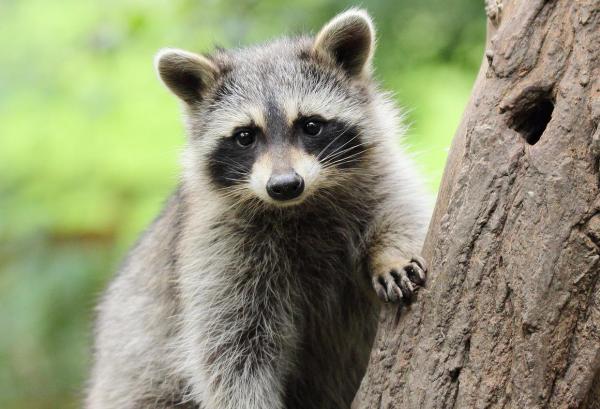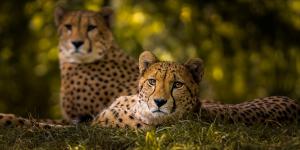How Do Raccoons Reproduce?


The raccoon (Procyon lotor) stands out as a truly remarkable creature in the animal kingdom, exhibiting exceptional adaptability and resourcefulness. With their iconic mask-like facial markings and remarkable agility, these small mammals have managed to thrive in a variety of habitats, ranging from urban areas to suburban and rural environments throughout North America. Their reproductive strategy, coupled with their remarkable adaptability, enables them to establish and sustain thriving populations, even in the face of diverse environmental conditions.
An AnimalWised article provides an overview of raccoon reproduction, including their mating season, social dynamics, and parental tactics.
What are raccoons?
Raccoons are medium-sized mammals, with an average length of around 60 to 90 centimeters (2 to 3 feet), excluding their bushy tail, which can extend an additional 25 to 40 centimeters (10 to 16 inches). In terms of weight, they typically range from 4.5 to 14 kilograms (10 to 30 pounds), although variations can exist based on factors like region, habitat, and food availability. These creatures are recognized for their distinctive features, including a pointed snout, a masked face, and a ringed tail.
Raccoons are native to North America, specifically found in various habitats throughout the continent, including the United States, Canada, and parts of Mexico. Originally, their range was primarily concentrated in wooded areas close to water sources, such as marshes, rivers, and lakes. However, due to their adaptability and resourcefulness, raccoons have expanded their habitat range and can now be found in a wide array of environments, including forests, urban and suburban areas, farmlands, and even coastal regions.
They are omnivorous, feeding on a wide range of foods such as fruits, nuts, insects, small animals, and even human leftovers. Raccoons are also known for their dexterity, using their front paws almost like hands to manipulate objects and explore their surroundings. They are nocturnal animals, primarily active during the night, and are known for their intelligence and problem-solving abilities.

How many species are there of raccoons?
Raccoons primarily belong to the species Procyon lotor, commonly known as the common raccoon. However, there are several recognized subspecies of raccoons with distinct characteristics and geographical distributions. These include:
- Eastern Raccoon (Procyon lotor lotor): found in the eastern regions of North America, including parts of the United States and Canada.
- Mexican Raccoon (Procyon lotor mexicanus): native to Mexico and certain areas of Central America.
- Florida Raccoon (Procyon lotor elucus): specific to Florida, USA.
- Pacific Raccoon (Procyon lotor pacificus): found in the western regions of North America, along the Pacific coast of the United States and Canada.
We invite you to explore our other article, where we delve into the fascinating world of raccoon-like animals and provide a comprehensive overview of the raccoon family tree.
How do raccoons reproduce?
Raccoons reproduce through sexual reproduction.
During the mating season, male raccoons, called boars, actively seek out females, known as sows, for mating. Male raccoons may engage in behaviors to attract the attention of females, such as vocalizations, posturing, and displaying their physical prowess. They may emit vocal calls or purring sounds to communicate their presence and interest to nearby females.
When a male raccoon encounters a receptive female, he may approach her cautiously and engage in physical interactions. This can include sniffing, nuzzling, and licking the female, as well as engaging in gentle biting or nibbling. These behaviors help establish and strengthen the bond between the male and female. Once the female raccoon accepts the male's advances, copulation takes place. Raccoons mate through internal fertilization, and copulation typically lasts for a brief period.
When is raccoon mating season?
The mating season for raccoons typically occurs in late winter to early spring, although it can vary depending on the region and climate.
Do raccoons mate for life?
No, raccoons do not typically mate for life. They are not monogamous animals, and their mating relationships are usually temporary. During the mating season, male raccoons may mate with multiple females, and females may mate with different males as well. After mating, the male and female raccoons generally go their separate ways.
How does a raccoon give birth?
After successful mating, the female raccoon becomes pregnant and will give birth to a litter of kits after a gestation period of around 63 to 65 days.
The mother raccoon selects a suitable den, often in a tree cavity, hollow log, or other sheltered location, to give birth and raise her kits. The den provides protection and security for the vulnerable young.
The female raccoon gives birth to a litter of usually 2 to 5 baby raccoons, known as kits. However, although larger litters are possible. The kits are born blind, deaf, and with little fur, and they are entirely dependent on their mother for survival. The mother nurses her kits regularly, typically lying on her side or back to allow them access to her teats.
As the kits grow, the mother introduces them to various skills necessary for survival. She teaches them how to climb, forage for food, and interact with their environment. The mother demonstrates these skills herself, and the kits learn by observing and imitating her actions.
Around 8 to 10 weeks of age, the kits start transitioning to solid foods. The mother begins to introduce them to a wider variety of food sources, including fruits, insects, small vertebrates, and even human-provided food in urban environments. As the kits become more proficient in finding their own food, they gradually become less dependent on their mother's milk. Eventually, the kits become independent and separate from their mother, usually around 9 to 12 months of age.
The duration of parental care can vary, but typically, the mother's role in raising the kits lasts for several months until they reach a level of independence. Raccoons reach sexual maturity at around 1 year of age, but they usually do not breed until their second year.
They have a relatively long lifespan in the wild, often ranging from 2 to 3 years for urban raccoons, while those in natural habitats can live up to 5 to 7 years or more.
If you are interested in learning more about raccoons' nutritional habits, you may find this other article helpful.
If you want to read similar articles to How Do Raccoons Reproduce?, we recommend you visit our Facts about the animal kingdom category.
- Baker, R. (2013). " Procyon pygmaeus Animal Diversity Web. University of Michigan, Museum of Zoology. Available at: https://animaldiversity.org/accounts/Procyon_pygmaeus/
- Groves, C. (2005). Wilson, D.E.; Reeder, DM, eds. Mammal Species of the World (3rd edition). Baltimore: Johns Hopkins University Press. p. 155. Available at: http://www.departments.bucknell.edu/biology/resources/msw3/browse.asp?id=14001658
- Fox, R. 2001. " Procyon lotor ." Animal Diversity Web. University of Michigan, Museum of Zoology. Available at: https://animaldiversity.org/accounts/Procyon_lotor/
- Phillips, N. (2005). "Procyon cancrivorus". Animal Diversity Web. University of Michigan, Museum of Zoology. Available at: https://animaldiversity.org/accounts/Procyon_cancrivorus/






